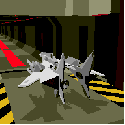|
gradenko_2000 posted:This is kind of a specific question, but I've been trying to figure out how to simulate how an Enigma Machine actually works, partly because I want to write a simulator for it as a programming exercise. I keep trying to make heads and tails of these instructions, but I end up just getting more and more confused and the decryption never comes out right. There is a book, called "The Code Book" by Simon Singh http://www.amazon.com/Code-Book-Science-Secrecy-Cryptography/dp/0385495323 That has an entire chapter on how Enigma works and how they cracked it. I have it, and looking at it now, it seems to describe it pretty well, with diagrams too. And yes, if an ancient computer in ww2 could figure out Enigma, im pretty sure a modern machine should have no problem brute forcing it. Does this help- " The machine has several variable settings that affect the operation of the machine. The user must select three rotors from a set of rotors to be used in the machine. A rotor contains one-to-one mappings of all the letters. Some Enigma machines had more than 3 rotors which just added to the number of possible encryption combinations. The other variable element in the machine is the plug board. The plug board allowed for pairs of letters to be remapped before the encryption process started and after it ended. When a key is pressed, an electrical current is sent through the machine. The current first passes through the plug board, then through the three rotors, through the reflector which reverses the current, back through the three rotors, back through the plug board and then the encrypted letter is lit on the display. After the display is lit up, the rotors rotate. The rotors rotate similar to an odometer where the right most rotor must complete one revolution before the middle rotor rotated one position and so on. As the current passes through each component in the Enigma machine, the letter gets remapped to another letter. The plug board performed the first remapping. If there is a connection between two letters, the letters are remapped to each other. For example if there is a connection between "A" and "F", "A" would get remapped to "F" and "F" would get remapped to "A". If this isn't a connection for a particular letter, the letter doesn.t get remapped. After the plug board, the letters are remapped through the rotors. Each rotor contains one-to-one mappings of letters but since the rotors rotate on each key press, the mappings of the rotors change on every key press. Once the current passes through the rotors, it goes into the reflector. The reflector is very similar to a rotor except that it doesn't rotate so the one-to-one mappings are always the same. The whole encryption process for a single letter contains a minimum of 7 remappings (the current passes through the rotors twice) and a maximum of 9 remappings (if the letter has a connection in the plug board). In order to decrypt a message, the receiver must have the encrypted message, and know which rotors were used, the connections on the plug board and the initial settings of the rotors. To decrypt a message, the receiver would set up the machine identically to the way the sender initially had it and would type in the encrypted message. The output of typing in the encrypted message would be the original message. Without the knowledge of the state of the machine when the original message was typed in, it is extremely difficult to decode a message." Saint Celestine fucked around with this message at 05:06 on Oct 19, 2012 |
|
|
|

|
| # ? Jun 2, 2024 10:36 |
|
SlothfulCobra posted:My favorite part of the cold war is the space race. Soviets get the first man in space, then the first satellite, but then America gets the first man on the moon, and that means we won. Well, the Soviet's lunar rocket (the N-1) kept on blowing up, while the American Saturn V was pretty good (except for Tom Hank's mission, of course). The Apollo 1 accident was due to bad design flaws in the capsule, so were easier to iron out. Of course, the Soviet's program was very secretive, so we didn't know how they were doing or how much resources were allocated to the project. We assumed that they were as serious about it as we were, pursuing our dream of conquering the moon with brutal Soviet efficiency, when it turns out that it was mostly a side project for them.
|
|
|
|
SlothfulCobra posted:My favorite part of the cold war is the space race. Soviets get the first man in space, then the first satellite, but then America gets the first man on the moon, and that means we won. The Soviets did get the first remote operated rover on the moon which in a lot of ways is a bigger accomplishment scientifically. They landed their first one in 1970 and tried sending 2 to Mars as well in 1971, one of which actually did land. I guess they saw a lot more military advantage to having remote controlled robots than can prowl around desolate/rough terrain. We just stuck to people and landing craft until 1996, when we sent the Sojourner rover to Mars. It's kind of crazy that even on Mars, you could find evidence of the cold war (if you knew where to look). It's a reasonable excuse at any rate because the entire time we were working on a manned landing, they were working on the rover. They were on track to beat us with the rover even but they hosed the first attempts up. They weren't going in a different direction because they lacked the technology; the rover they built was a real engineering accomplishment, literally the first remote operated space rover ever. They don't really have anything to rationalize except for the fact that it took them something like 2-3 tries to actually get the rover to the moon. And I want to clarify, the original post should really say "a manned landing on the moon" because the USSR did land on the moon several times and was working on it at the same time that the Apollo project was happening. VVVVVVVVVVVVVVVV BoutrosBoutros fucked around with this message at 07:54 on Oct 19, 2012 |
|
|
|
SlothfulCobra posted:I remember reading somewhere that around the time we were landing on the moon, the Soviets realized that there was no practical military application for landing on the moon at the time, which is why they slackened off. Of course that's the reason, that's doesn't sound at all like a retrospective excuse
|
|
|
|
gradenko_2000 posted:This is kind of a specific question, but I've been trying to figure out how to simulate how an Enigma Machine actually works, partly because I want to write a simulator for it as a programming exercise. I keep trying to make heads and tails of these instructions, but I end up just getting more and more confused and the decryption never comes out right. There are plenty of existing scripts out there that do this: http://russells.freeshell.org/enigma/ for example
|
|
|
|
tallkidwithglasses posted:A lot of Soviet and US doctrine is only now slowly getting declassified so details are still relatively scarce, but MAD was absolutely A Thing and basically ever since the nuclear arms race began it was the stated policy of the United States to respond in kind to any WMD attack. Since the United States started spooling down their chemical arsenal and research into bioweapons during the middle of the Cold War, that meant that any WMDs used against the US would result in the US nuking whoever did it. I know the stated policy of the US was that it would use nuclear weapons to Keep Europe Free. But would this actually have happened, or would the US say, "Sorry, Europe, but we don't want NYC nuked." I know this is a very "what-if" question, which is why I asked originally if any analysis had been done to determine the realistic US response.
|
|
|
|
Oxford Comma posted:I know the stated policy of the US was that it would use nuclear weapons to Keep Europe Free. But would this actually have happened, or would the US say, "Sorry, Europe, but we don't want NYC nuked." Both sides tended to take the public stance that they'd only go nuclear if the other side went nuclear first, but there's a definite intersection between the US policy (which was basically to respond with total overwhelming nuclear war if ANY WMD were used in any capacity), and the Soviet policy, which made allowance for the tactical application of low-yield nuclear devices without escalating to nuclear apocalypse. This is all ridiculously hypothetical and total speculation so please don't interpret this as good history or anything, but my general opinion is if the Soviet Union started rolling through the Fulda Gap, there is a reasonable chance they would have used nuclear artillery to pin down a choke point or something and that would have prompted a full scale US retaliation with ICBMS.
|
|
|
|
Slothful Cobra posted:No military value in space Is there a treaty or something which explains why we don't have a military space station that can launch nukes or do some other crazy stuff?
|
|
|
|
KildarX posted:Is there a treaty or something which explains why we don't have a military space station that can launch nukes at anyone in relative safety? Outer Space Treaty.
|
|
|
|
KildarX posted:Is there a treaty or something which explains why we don't have a military space station that can launch nukes or do some other crazy stuff? The only space station with military capability that was ever launched was a Soviet Almaz station. It was equipped with this: http://en.wikipedia.org/wiki/Nudelman-Rikhter_NR-23 and was test-fired once.
|
|
|
|
KildarX posted:Is there a treaty or something which explains why we don't have a military space station that can launch nukes or do some other crazy stuff? DerLeo posted:Outer Space Treaty. You mean the ion cannon won't be coming online soon? Alchenar posted:not to mention the US system which despite not even coming close to tapping its manpower reserves decided that the best way of managing recruits was to let other services skim the cream as much as they want until only the dregs of the lowest quality made it to the infantry. Is this to mean, and I'm sure the enlistment process was different then than it is now, if a guy went down to the local recruiting station and said "sign me up for the war effort" they didn't go through a job selection process, but rather they were all essentially open general and infantry consistently got the lowest recruits? Why would they get the lowest recruits? I can understand not sending the best and brightest out, but is this the underweight and half retarded guys? I always thought infantry selection would be above that and the worst would be truck drivers, cooks, or just incredibly boring and monotonous jobs? Does any of that still hold true today or what has changed?
|
|
|
|
I seem to recall from one memoir from an enlistee that recruits were classified "A", "B", and "C", with healthy young lads (A) being sent into the infantry, people a little worse for the wear (B) were tankers, artillery, support and the like, while "C" dudes were cooks and stretcher-bearers. He had dropped out of high school to enlist in 1945, so things might have been different than someone enlisting in 42 or drafted in 44.
|
|
|
|
There's also the fact that a lot of the people of military age had grown up in the great depression. IIRC there was discussion earlier of malnutrition and other problems as a result of that.
|
|
|
|
Saint Celestine posted:And yes, if an ancient computer in ww2 could figure out Enigma, im pretty sure a modern machine should have no problem brute forcing it. Could you really brute force an Enigma message with a WW2 era computer though? I thought that even with a complete understanding of how the Enigma engine worked, decoding messages sent with the later versions was only possible due to a combination of sloppy operation by the Germans and some clever guesswork by the Allies
|
|
|
|
GreenCard78 posted:You mean the ion cannon won't be coming online soon? More like "if you know how to cook, we'll make you a cook." Infantry got guys who couldn't cook or fix a truck or do the math needed for the artillery or otherwise demonstrate aptitude for any other job. You see, anyone can be trained to be an infantryman. Supposedly.
|
|
|
|
Thanks Saint Celestine and Blckdrgn. I actually figured where I was getting it wrong: I read "ABCD ..." in the reflector column and assumed it was just the alphabet in normal order, which is kind of silly in hindsight. Once I had corrected that mistake I was able to successfully cipher EINSEINS into BHQPWDEV with an initial rotor setting of AAZ. Quite a nerdy accomplishment, but it made my day to puzzle it out with the help of your added info.
|
|
|
|
Anyone in good physical shape can hold a gun and carry heavy stuff around, but people that know math or medicine or are short enough to fit into a tank are too valuable to do menial labour. This being the 1940s, there was probably no shortage of people not educated enough to do anything but infantry.
|
|
|
|
GreenCard78 posted:Is this to mean, and I'm sure the enlistment process was different then than it is now, if a guy went down to the local recruiting station and said "sign me up for the war effort" they didn't go through a job selection process, but rather they were all essentially open general and infantry consistently got the lowest recruits? Why would they get the lowest recruits? I can understand not sending the best and brightest out, but is this the underweight and half retarded guys? I always thought infantry selection would be above that and the worst would be truck drivers, cooks, or just incredibly boring and monotonous jobs? Does any of that still hold true today or what has changed? What the other people said. Basically (and note that I'm referring mainly to the replacement system) the idea was to grab anyone without a specialisation and put them in depots to be used to bring front line units up to strength. In panic situations (ie. the Battle of the Bulge) they didn't even bother making sure everyone even had infantry training. This was less of an issue in the US than in other countries, but in WW2 the criteria for going into the Tank corps was generally whether you were one of the few people who'd seen a car engine before. e: there's also a big difference between how manpower gets allocated in a professional army and how manpower gets allocated in a total-mobilisation conscript army. Alchenar fucked around with this message at 20:44 on Oct 19, 2012 |
|
|
|
20th century firearms are trivially easy to fire so yes anyone can be an infantrymen and do good enough for the purposes of being shot at.
|
|
|
|
This sort of thing didn't change enormously going into the 80's in the British Army, new enlistees were given aptitude tests that basically involved lower scores getting potential specialisations crossed out. Basically it got down to the lowest percentiles that had infantry and pioneer, so the infantry had (and to an extent still have) a reputation for being blockheads that get pointed at the enemy and need smart officers to properly herd them. This particular view came from a Cavalry Sergeant Major, who explained in the same instance that this was why the British army's cavalry officers are all inbred idiots, since the more intelligent and independent non-coms can handle things without them. But yeah, the result is anyone with brains and talent is considered too valuable to use doing relatively straightforward tasks you can train people for far more quickly, especially when that specific task results in much higher casualty rates.
|
|
|
|
KildarX posted:Is there a treaty or something which explains why we don't have a military space station that can launch nukes or do some other crazy stuff? The Outer Space Treaty stops us from putting weapons of mass destruction in orbit, but we probably would do it anyway if we thought there was a cost effective benefit to it. I'm relatively sure more conventional weapons of less-than-mass destruction are still allowed, but we don't do that either. I'm pretty sure it's really a cost thing more than anything else. Now, the Space Shuttle was designed with potential military purposes in mind. The first design ideas for it were significantly smaller than the one we ended up building, but the Air Force was brought in and had some ideas. They wanted the Space Shuttle to be able to pick up a Soviet satellite and bring it back to Earth, among other things. The Air Force was even planning on having it's own shuttle fleet completely separate from NASA's. The USSR wasn't oblivious to all of this, and was actually really concerned about it. So they built The Buran Shuttle which is almost exactly the same as ours because they copied the hell out of it. Ultimately the US Space Shuttle entered service as the cold war was winding down, and the Buran wasn't finished until 7 years later, so the potential military applications never got put to real use.
|
|
|
|
BoutrosBoutros posted:The Outer Space Treaty stops us from putting weapons of mass destruction in orbit, but we probably would do it anyway if we thought there was a cost effective benefit to it. I'm relatively sure more conventional weapons of less-than-mass destruction are still allowed, but we don't do that either. What do you mean "we," paleface? The Soviets had several orbital weapons systems, including an ASAT program that would place a killer satellite into orbit that was intended to close to within a few hundred meters of a target satellite and then blow itself up. A number of these were successfully and destructively tested against target satellites and there are still some fragments from those tests floating around up there. The Soviets didn't abandon that program until at least 1983. They also had a manned orbital reconnaissance program called Almaz, they were covered as Salyut space stations but they were armed military satellites, the Soviets adapted the 23mm tail gun from the Tu-22 for space and stuck it on the station in a fixed mount. And didn't someone just post a picture of Polyus (or was that the spaceflight thread)? That was supposedly a big fuckoff CO2 laser.
|
|
|
|
They turned a Buran prototype into a kickass ride in Gorky Park. Obviously not the one used in anything interesting, but it's cool to see (and go inside of).
|
|
|
|
Phanatic posted:What do you mean "we," paleface? I mean "we" as in like, the entire world, because none of that stuff is actually around any more, beyond the leftover debris of it. I didn't say that nobody ever bothered with it, in fact the rest of my post was about a spaceship the US designed to be a weapon if we needed it to be. All the actual weapons were cold war experimental poo poo and since the cold war is over, nobody who can actually get poo poo into space bothers to put weapons into space (I guess there could be top secret weapons in space).
|
|
|
|
Fornadan posted:Could you really brute force an Enigma message with a WW2 era computer though? It was a combination. Human lazyness on the part of German operators sometimes used repeated keys, and some messages would often contain words that the British knew would be in there. I.e. Reports from Weather ships would contain the German word "wetter" for weather. Given a few breaks, and with Turing's help, they narrowed it down from 1.59x10^19 combinations to like 1 million combinations. The British built a bunch of machines called "bombes" that worked on solving these every day. My book says on lucky days they could decipher a message within an hour. Obviously much of it was caused by German rigidity and their idea that Engima was completely unbreakable. So no, it wasn't "brute force" but deducing a likely combination to narrow down the "brute" force work. Even a modern day computer would take a while to "brute force" Enigma I think, but if you made a set of parameters, it could do it within a few seconds or minutes I think.
|
|
|
|
Saint Celestine posted:It was a combination. Human lazyness on the part of German operators sometimes used repeated keys, and some messages would often contain words that the British knew would be in there. I.e. Reports from Weather ships would contain the German word "wetter" for weather. Not to detract from Turing's role, not even to say that Turing's role is overstated, but it bugs me when his name's the only one that comes up in breaking the Enigma. The original, the really groundbreaking work, was done by the Poles, specifically Marian Rejewski. The Enigma had already been around in two-rotor commercial versions, but the German army started using a three-rotor version to pass message traffic, and Rejewski's group broke it *purely through cryptanalysis*. I want to repeat this, because it's staggering: without ever seeing or laying their hands on an Enigma machine, they essentially constructed a perfect functional duplicate of one purely through mathematical analysis of the messages sent over it. If there was a Nobel Prize in Badass Mathematics, these guys deserved it. They did this just in time to start reading German messages saying "Hey, we're going to invade Poland," so they got the hell out to England and brought their equipment and their research with them, and that's what Turing *started* with. He built machines called bombes, they got their name from what the Poles called their machines: bomba.
|
|
|
|
Also, if you guessed that "bombe"/bomba is related to "bomb", you're right. The original full name for the prototype was bomba kryptologiczna: "cryptologic bomb".
|
|
|
|
Phanatic posted:And didn't someone just post a picture of Polyus (or was that the spaceflight thread)? That was supposedly a big fuckoff CO2 laser. That would have been me in the military pics thread. Btw the first US and second overall unmanned shuttle in space might just be a weapons platform but we know gently caress all yet.
|
|
|
|
Fornadan posted:Could you really brute force an Enigma message with a WW2 era computer though? That last bit is how they managed to "brute-force" the Enigma even with just 40s-era electromechanical computers. Saint Celestine touched on this with how operators would get sloppy in configuring their machines, but a big part was also looking for patterns in how messages were composed. One of the big breakthroughs was finding out that operators were expected to spell out numbers explicitly, instead of using numerical characters. You would then look for machine configurations that would result in EINS, or the German word for 'one'. Other operators would start their messages the exact same way every time, which was another big clue. As far machine configuration, sometimes they would either be prohibited from using the same one in the same month, meaning you'd have a pool that you could gradually eliminate over time, while other times they'd repeat the orders from previous months. Another idea was how people with combination locks would only shift the lock away from the real thing by a couple of notches, as well as plugboard settings where no two letters that were physically adjacent on the machine would be plugged together.
|
|
|
|
How where these messages gotten in the first place? Clandestine folks sorting through trash?
|
|
|
|
KildarX posted:How where these messages gotten in the first place? Clandestine folks sorting through trash? Radio intercepts.
|
|
|
|
gradenko_2000 posted:I guess I should have qualified my statement a little more: You can probably brute-force an Enigma with current hardware, as in have it try out all possible rotor and stecker/plugboard combinations, but a lot of the results are going to be gibberish, since technically any rules you'd program into the brute-force technique would only account for impossible machine configurations. That is, someone would still have to sort through the output to look for which outcomes result in real words. It would be easy to compare the resulting outputs to a dictionary, that's the whole reason why passwords are supposed to have numbers and symbols.
|
|
|
|
Encrypted messages are frequently sent in 4 letter blocks instead of preserving the original spacing, just to make that more difficult.
|
|
|
|
Ensign Expendable posted:Encrypted messages are frequently sent in 4 letter blocks instead of preserving the original spacing, just to make that more difficult. And messages still have codes in them. Particular common words like "destroyer" had like 20 different ones.
|
|
|
|
gradenko_2000 posted:That is, someone would still have to sort through the output to look for which outcomes result in real words. There was a distributed computer project several years ago to crack three remaining encrypted Enigma messages using a hillclimbing algorithm. Try a plugboard combination, and evaluate the output for how natural-languagelike it appears, and iterate. The least-difficult portion of that project was sorting through the output to look for which outcomes result in something that looks like a natural language, you don't need a person to do that part of it at all. One message took less then a month, the next took about another month, then they never got the third one and I think the project shut down or at least went on really long hiatus. I think the real keyspace of a 4-rotor KM Enigma (not the theoretical keyspace, I mean the real one taking into account the limits of the physical construction of the thing, things like the fact that the 4th rotor doesn't move when you encrypt a message like the other three do, or that it's incapable of encrypting a letter to itself) is something like 80 bits. That's big, but distributed.net brute-forced a 64-bit RC5 key 10 years ago, an 80 bit key would require 2^16 times as much raw computation power. Phanatic fucked around with this message at 06:13 on Oct 21, 2012 |
|
|
|
Yay, cryptology chat! While we're on the subject, there's one thing I've alway wondered about: How useful would it be to take a message, run it through one cypher and then take the output and run it through yet another, different cypher? It seems to me like that would make it way harder to break the code, given that you couldn't tell on a glance whether your result is worth anything. Yet it looks like many WWII codes just went from plaintext to code in one step and that's it. Are the benefits of stacking one code on top of another just not as great as I'm thinking or would that be too error-prone/time-consuming or what?
|
|
|
|
Perestroika posted:Yay, cryptology chat! While we're on the subject, there's one thing I've alway wondered about : How useful would it be to take a message, run it through one cypher and then take the output and run it through yet another, different cypher? It seems to me like that would make it way harder to break the code, given that you couldn't tell on a glance whether your result is worth anything. You need a system that's complex enough that it can't be easily broken, but not so complex that it can't be readily decoded by the person it's intended for. This is why, say, diplomatic traffic has generally been heavily encoded by those who care, whereas battlefield traffic is less so.
|
|
|
|
Perestroika posted:Yay, cryptology chat! While we're on the subject, there's one thing I've alway wondered about : How useful would it be to take a message, run it through one cypher and then take the output and run it through yet another, different cypher? It seems to me like that would make it way harder to break the code, given that you couldn't tell on a glance whether your result is worth anything. I don't think there'd be that many benefits for the Germans doing that. While it'd confuse the codebreakers at Bletchley Park, it'd just as easily confuse the intended recipients. How would the Germans know it was a valid Enigma translation if when they translate it, it just spits out more gibberish? Plus, were it done as you described, there'd be no way of the intended recipient knowing what rotor settings to use for any given message, "Is this the first or second layer of encryption?"
|
|
|
|
One of the big benefits of the Enigma system was that deciphering the text was just as easy as enciphering it: Just feed the enciphered text into the same machine with the same rotor and plugboard settings. "Double encryption" makes it harder to break, but also makes it much harder to use in general, and may well lead to more sloppy practice that makes your encryption vulnerable to human-nature-related attacks anyway. === Did Allied fighters such as the Typhoon and the Thunderbolt have enough machine-gun/cannon firepower to puncture a Tiger or a Panther's top armor? If not, would rockets have been enough, or would you have really needed an outright bomb to damage those tanks? gradenko_2000 fucked around with this message at 16:50 on Oct 21, 2012 |
|
|
|

|
| # ? Jun 2, 2024 10:36 |
|
gradenko_2000 posted:One of the big benefits of the Enigma system was that deciphering the text was just as easy as enciphering it: Just feed the enciphered text into the same machine with the same rotor and plugboard settings. "Double encryption" makes it harder to break, but also makes it much harder to use in general, and may well lead to more sloppy practice that makes your encryption vulnerable to human-nature-related attacks anyway. I know Mustangs were pretty drat successful using rockets to destroy the larger German tanks.
|
|
|






























